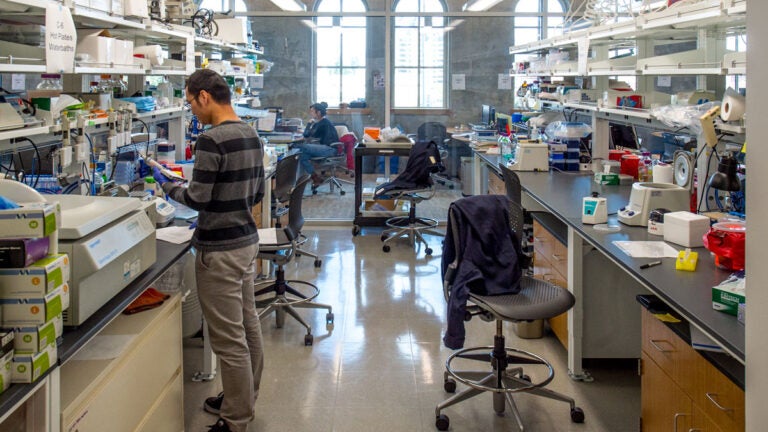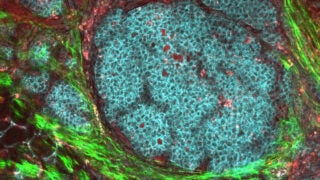
Michelson Hall is set up with areas for careful lab work, while open spaces encourage researchers to meet and share ideas. (Photo/ Gus Ruelas)
The Race to Discover New Drugs Ramps Up at USC
Academic researchers, family members and industry join forces to fight serious diseases. It’s what can happen at a place like the USC Michelson Center for Convergent Bioscience.
In 2002, Alison Michaux Reynolds gave birth to her first child, Tia, and the baby seemed perfect. But within a day of their release from a San Francisco hospital, Reynolds received an urgent call. Lab staff had tested Tia’s blood sample, and they had news.
“Put her in a car seat and stop breastfeeding her,” the staff member told her. “We need you to come here right now.”
Tia had the rare inherited metabolic disease phenylketonuria, or PKU. That meant that if she consumed any protein, she could suffer brain damage. Reynolds was so upset, she threw the phone across the room.
PKU had no cure. Yet.
Today, patients have a new drug to fight the effects of PKU, and another is on the way. These drugs will change the lives of the thousands of people with the disease.
Scientists and physicians at USC and similar leading research institutions nationwide now play a significant role in discovering new drugs and creating new devices. For rare diseases like PKU, few pharmaceutical companies will take on the huge investment and risks associated with designing drugs. But a convergence of scientists, doctors, institutions, families and philanthropists dedicated to the cause can make all the difference to drug discovery and development.
At USC, much of the search for new drugs now happens at the USC Michelson Center for Convergent Bioscience, named through a generous $50 million gift from orthopedic surgeon Gary K. Michelson and his wife, Alya Michelson. Opened on the USC University Park Campus in Los Angeles in late 2017, the USC Michelson Center takes on big problems in health. Its dozens of researchers from diverse fields work together to seek out better ways to diagnose, prevent and treat disease.
By creating the USC Michelson Center, USC joined a growing number of private institutions, from the Massachusetts Institute of Technology to Johns Hopkins University, that have heavily committed to facilities and researchers who conduct what’s commonly called translational science. New medicines and devices would be impossible without this movement of basic science findings from labs into clinical testing with patients.
The USC researchers have a track record of drug discovery and already are making strides against diabetes, cancer and other diseases that affect millions of people worldwide. At the same time, they know their work could potentially touch people struggling with much rarer conditions and few options to treat them.
DRUG DISCOVERY, BORN IN LOS ANGELES
The USC Michelson Center is home to Raymond Stevens ’88, a chemist and structural biologist. A USC alumnus and Provost Professor, Stevens directs the USC Michelson Center’s Bridge Institute. He knows the importance of finding new drugs and getting them to patients, because he has seen its impact firsthand — in patients with PKU.
One in every 10,000 to 15,000 infants in the United States is born with PKU. These children lack an enzyme called phenylalanine hydroxylase. This enzyme normally enables the body to break down an amino acid—phenylalanine—that’s found in all proteins in food, from poultry to peas.
In people with PKU, though, phenylalanine remains unconverted. It weaves its way through the bloodstream and clogs the blood-brain barrier, damaging brain tissue and causing developmental issues including moderate to severe retardation. There is no supplement or drug that PKU patients can take to break down the phenylalanine. They must eat little to no protein, and usually drink a formula every day.
The late Richard Koch, a researcher and pediatrician at the Keck School of Medicine of USC and Children’s Hospital Los Angeles, was such a pioneer in the field that he was dubbed “Dr. PKU.” For 50 years, Koch treated PKU patients and kept a lookout for a potential therapy beyond formulas and restrictive diets.
In 1997, five years before Tia’s birth, Koch found hope in the pages of a study published by Stevens — a professor at the University of California, Berkeley at the time — and his colleagues at the University of Tromsø in Norway. They had built a 3D model of phenylalanine hydroxylase, the critical enzyme to PKU. It was a feat that had long eluded scientists and was a critical step toward finding a drug to treat the disease.
Koch called Stevens and peppered him with questions about his discovery. He urged Stevens to come to L.A. and meet his team of nurses and doctors, as well as families who were living with PKU, and explain what he had found.
The phone call was the catalyst for new collaborative, convergent scientific research between Koch and Stevens. It also led Stevens to meet countless families struggling with PKU. These families wanted answers about the disease, and they raised vital money for research at The Scripps Research Institute, where Stevens had moved. His experiments laid the groundwork for potential drugs. Ultimately, so many families with PKU had united behind the research that they formed the National PKU Alliance. They would go on to influence research and development for treatments and monitoring devices.
Stevens and families with PKU eventually came into contact with a biotech company in the Bay Area called BioMarin Pharmaceutical, whose mission was finding treatments for rare childhood diseases. Together, they would turn lessons from lab research into new drugs tested through clinical trials.
BioMarin Pharmaceutical drew on parts of Stevens’ research to develop the drug Kuvan for mild PKU. Later, Stevens and BioMarin collaborated to develop Peg-Pal for the more severe form of PKU. Kuvan is now available by prescription, and researchers believe that the U.S. Food and Drug Administration will approve Peg-Pal this year.
THE CHANGING DRUG ECOSYSTEM
Approval for developing and launching one new drug in the United States carries a hefty price tag of about $2.6 billion. It also usually takes a long time — typically about 15 years, according to the Tufts Center for the Study of Drug Development, the top organization for monitoring drug research and development.
Drug discovery and development requires funding and resources at all phases, from the first studies in the lab through the final clinical trials. The process isn’t linear, either. Most drugs go through several different research groups and companies before they ever reach the market.
The National Institutes of Health is the most influential federal funding agency for USC and other research institutions that focus on basic science. But it’s typically risk-averse. Projects that lack reams of supportive data, even if they offer a glimmer of hope, are unlikely to get funded.
That’s why philanthropy has become so important, especially for research into so-called “orphan” or rare diseases. For many years, most pharmaceutical companies tended to avoid orphan drug development because of the investment it requires, both for discovering the drug and for putting it on the market to serve the small number of patients that it will treat.
But if patients, donors and nonprofits can fund researchers, they can change the course and pace of drug discovery. That’s the ecosystem that helped give rise to the USC Michelson Center.
In recent years, pharmaceutical companies have pulled back from some aspects of early drug research. Many big pharmaceutical companies now invest in drug discovery and development late in the process, when they face less risk of failure, says Steve Kay, Provost Professor of Neurology, Biomedical Engineering and Biological Sciences and director of convergent biosciences at the USC Michelson Center.
“They are getting out of the business of preclinical development, where drug candidates are identified prior to testing safety and efficacy in humans,” he explains.
That trend created the “Valley of Death” — a metaphorical chasm where basic science research findings sometimes tumble and disappear, never to be translated into new treatments for diseases. About 95 percent of potential new drugs never reach the market, according to the National Institutes of Health.
Today the pharmaceutical industry increasingly depends on institutes and leading research universities like USC to take on the initial stages of discovery. Investigators at USC design and run the lab experiments that reveal potential targets for treatments and establish the best drug candidates that should go on for testing in patients.
“Those types of capabilities that were once the domain of biotech and pharma companies are now the domain of universities,” Kay says.
Pharmaceutical companies also havefocused on launching second generations of pre-existing drugs, which keeps shareholders satisfied but detracts from innovation, Kay says. “But universities are not subject to the interests of shareholders and can drive that innovation.”
Dana Goldman, director of the USC Schaeffer Center for Health Policy and Economics, says the evolution makes sense. “There’s always been a complementary relationship between university-based science and drug development,” Goldman says. “This is exactly the kind of model that is needed. We need researchers to prove that the science works and then we need trained personnel with expertise to guide the drug through the regulatory process. It’s a very efficient model.”
HOME FOR INVENTORS
To bridge the gap between laboratory research and clinical trials, scientists and engineers often partner with an existing company or the university to launch a spinoff. Several of the USC Michelson Center for Convergent Bioscience scientists have extensive experience in spinoffs and drug launches.
Stevens, for example, started four successful companies to advance research from the laboratory while he was a scientist at The Scripps Research Institute, and he’s in the early stages of starting three new ones at USC. He and colleagues and graduate students created the San Diego startup Receptos, which developed a drug to treat multiple sclerosis that also shows promise for treating Crohn’s disease and ulcerative colitis. Receptos was acquired by a larger firm in 2015, and now the drug awaits final FDA approval.
Today, Stevens and colleagues at the Bridge Institute at the USC Michelson Center — chemist Vadim Cherezov and computational structural biologist Vsevolod Katritch, who also both came from The Scripps Research Institute — continue to create 3D models of important proteins that serve as targets for drugs. These proteins are receptors on the membrane that surrounds human cells.
Kay himself worked for 10 years at what is now the Genomics Institute of the Novartis Research Foundation and, later, for The Scripps Research Institute. His work contributed to new drugs such as Zykadia, which fights lung cancer. He also has spun out biotech companies such as Phenomix in San Diego, which developed type-2 diabetes drugs, and Reset Therapeutics in San Francisco, which develops drugs for diabetes, sleep disorders and cancer.
And the work continues at USC, where he remains focused on circadian biology to fight disease. This research revolves around the body’s biological rhythms. Kay and colleagues have developed so-called “small molecule” drugs that show potential for treating metabolic diseases, prostate and breast cancer, neurogliomas (spinal or brain tumors) and acute myeloid lymphoma, Kay says.
Peter Kuhn, Dean’s Professor and biophysicist at the Bridge Institute at the USC Michelson Center, this year launched a test to diagnose hormone-resistant prostate cancer. Kuhn did it through the diagnostic company Epic Sciences, which he founded before joining USC. The test analyzes tumor cells circulating in the blood. Doctors could use it to figure out the best treatments for each patient’s cancer, sparing patients from treatments unlikely to help.
Kuhn emphasizes the importance of partnerships among industry, government and academia. They’re critical to turning basic science discoveries into products used for medical care, he says.
“We have to work with industry to allow for our ideas and technical and scientific discoveries to have an impact on patients,” Kuhn says.
The USC Michelson Center overflows with entrepreneurs who spawn innovations. Scott Fraser is one of them. Fraser’s creative work in imaging has led to inventions like laser scanning microscopes and a new kind of instrument to create images of the eye. A Provost Professor at USC, Fraser has launched several startups as well. Among them is Varocto Inc., which is developing the next generation of tools to screen people at risk for serious eye disease due to retinal problems. Its technology is so gentle that patients can avoid having their pupils dilated or having dye injected into their eyes. The company spun off through the Alfred E. Mann Institute for Biomedical Engineering at USC.
Why come up with these inventions? Explains Fraser: “I had problems that I couldn’t find the solutions for.”
EXPERIENCE MATTERS
Michelson Hall, the home of the USC Michelson Center, buzzes with collaboration. Its scientists, engineers and inventors organize weekly lunches to talk about hot topics and their latest research. The meetings encourage a culture of exchange. Scientists and engineers who know how to develop drugs and devices and launch startups mentor less-experienced researchers who are trying to make the leap out of the lab for the first time.
The complicated process involving patent applications, clinical trials and FDA approval can be daunting. Chemical engineer and materials scientist Andrea Armani, a professor at the USC Michelson Center and USC Viterbi School of Engineering, is turning to experts like Fraser and Stevens for help with it.
We have to work with industry to allow for our ideas and technical and scientific discoveries to have an impact on patients.
Peter Kuhn
Armani has been working with David Agus, director of the Lawrence J. Ellison Institute for Transformative Medicine of USC, on testing a technology known as optical fiber polarmetric elastography. But you might call it a “tissue squisher.” It’s a diagnostic tool that could determine whether a lump in the body is cancerous, based on how firm it is. The stiffer a lump, the more aggressive the cancer — at least according to preliminary testing, Armani says.
It could take anywhere from three to seven years to gain FDA approval of the tool, she says, and she wants to launch a startup to expedite the process. That’s where her colleagues’ expertise will come in handy.
“This will be my first foray into having a startup company,” Armani says. “I am a novice at this. There are a lot of faculty here who have had a lot of startup companies, so having someone down the hall as a mentor is really helpful.”
Ultimately, scientists and engineers at the USC Michelson Center believe that by working together they’ll make a difference for future patients who desperately need treatment options.
These patients are people like Tia Reynolds, who is now 15 and still struggles with PKU. Every day, she can only safely eat as much protein as you’d find in a quarter of an egg, and she’s waiting for Peg-Pal to be approved to treat her severe form of the disease.
With the new drug, “she may not eat a steak,” her mother Alison Reynolds says, “but she could at least have pizza.”



